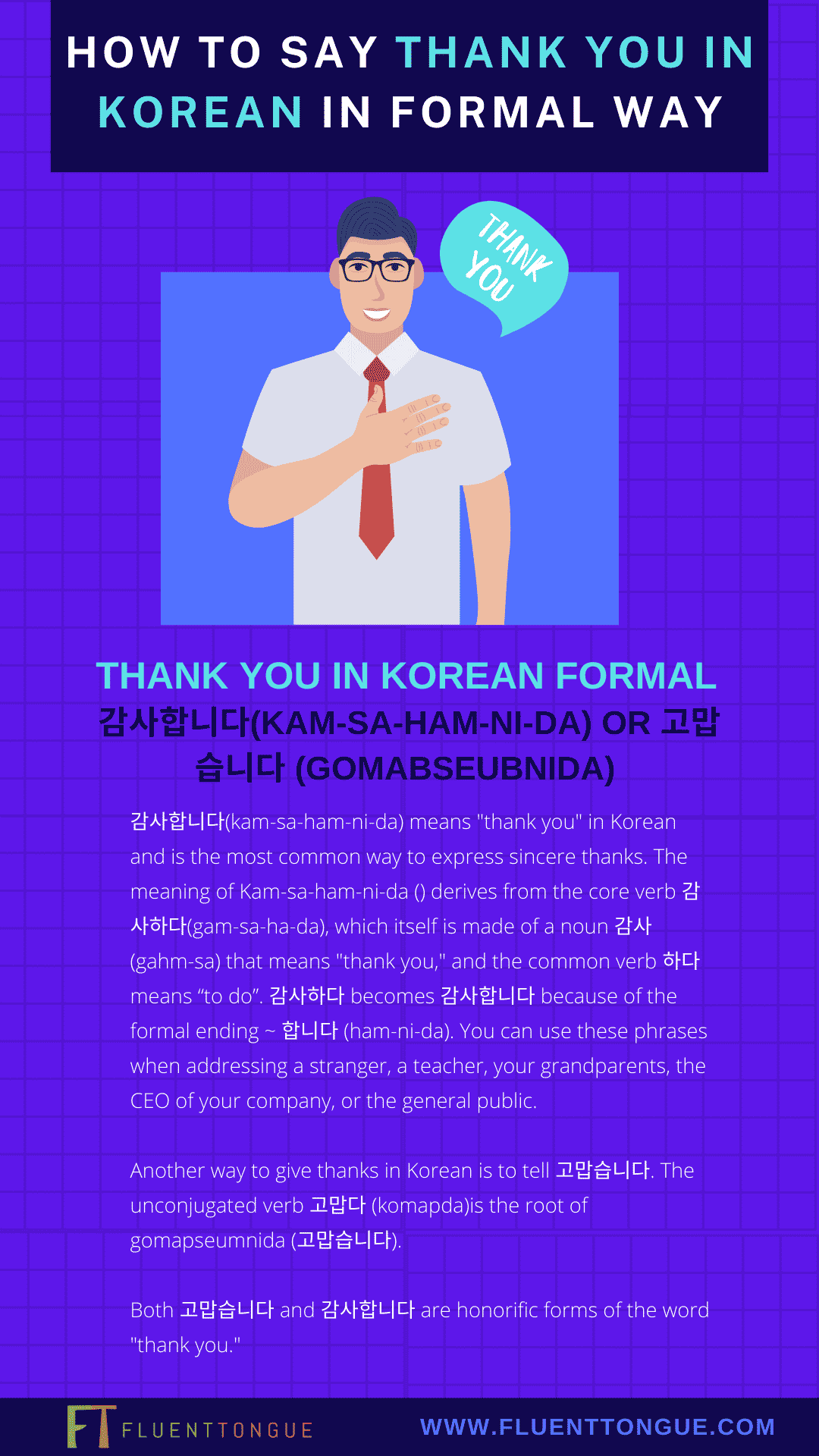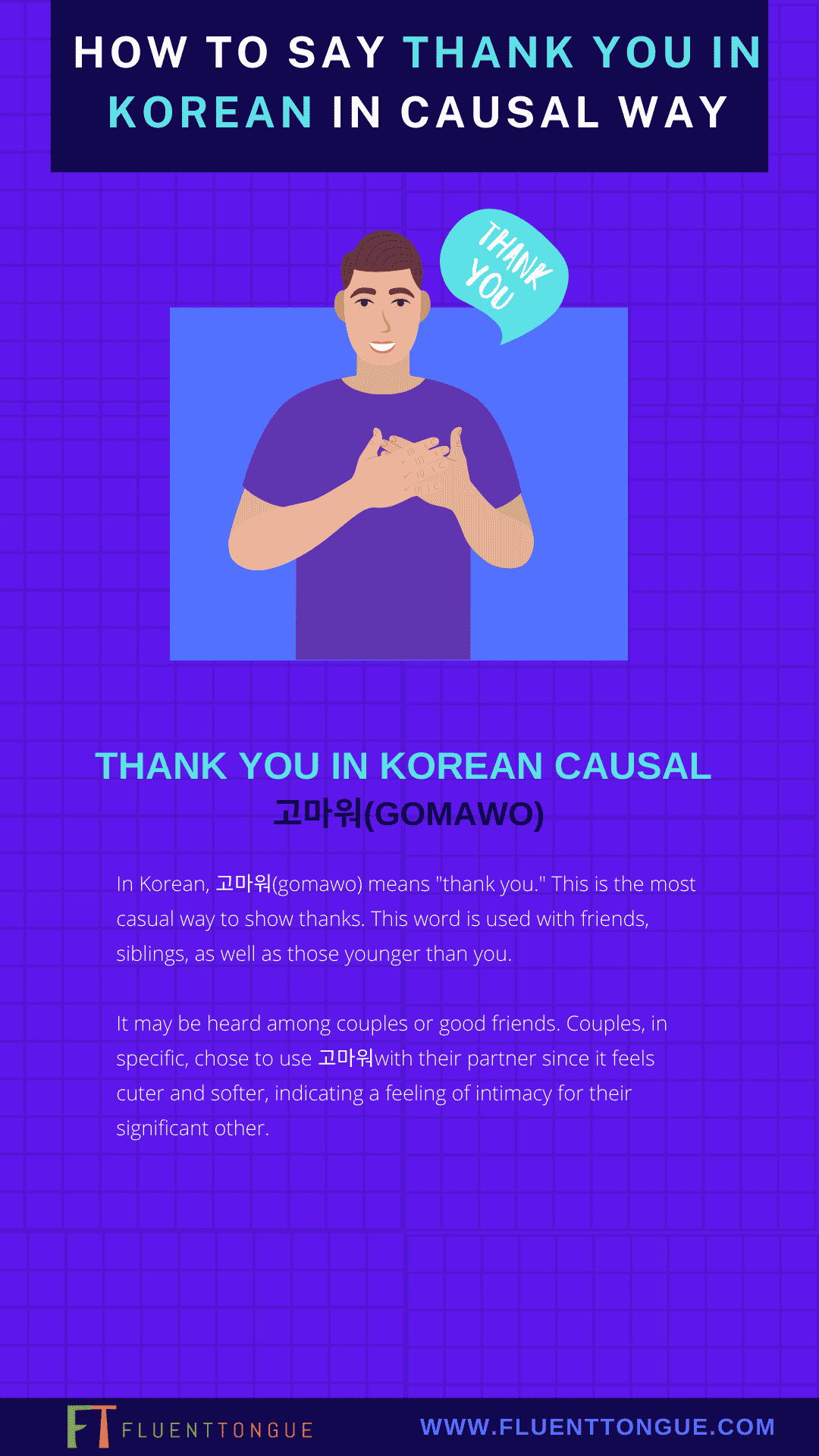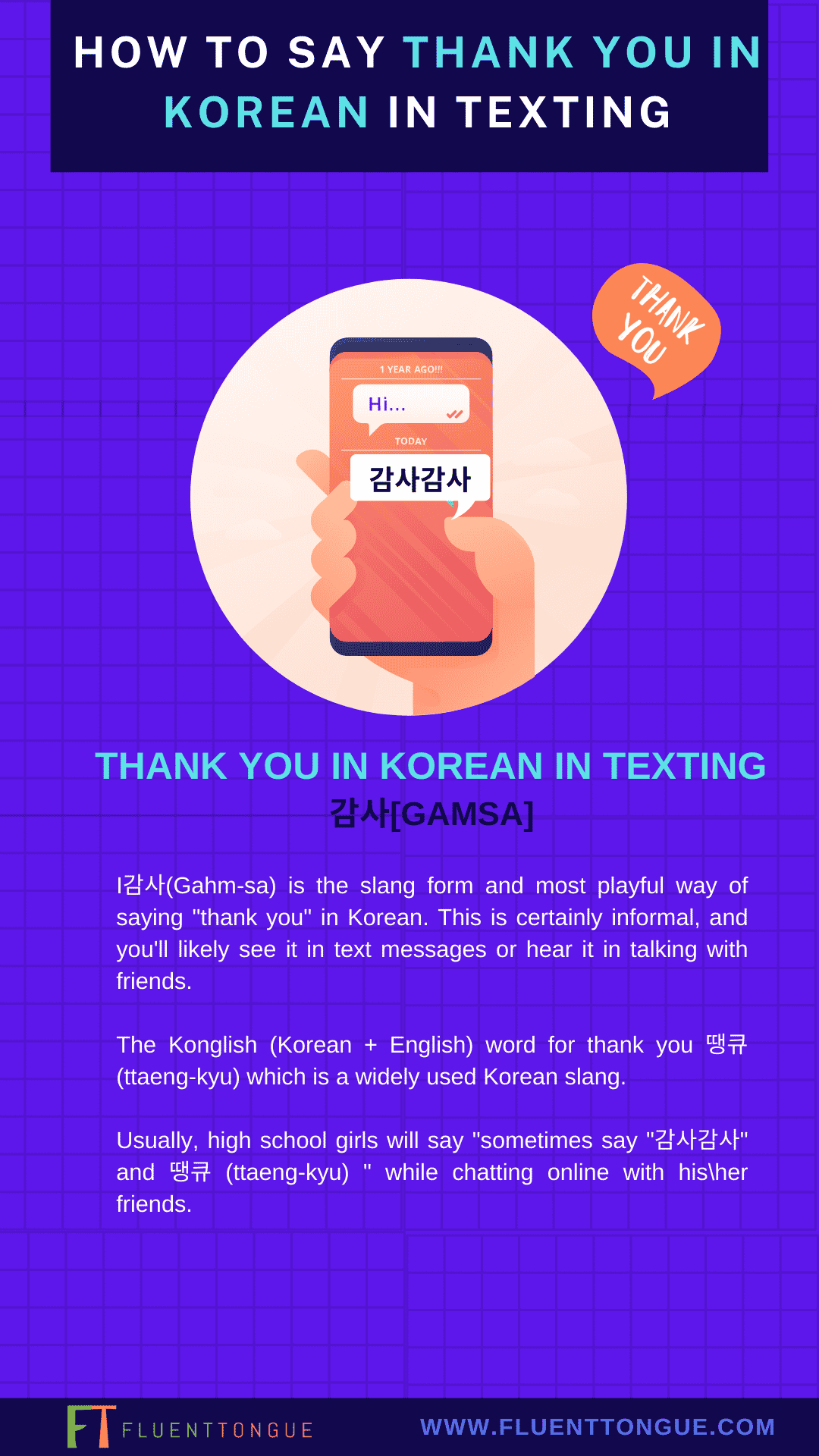Saying hello and thank you in Korean gives you more power(in a conversation)
Here’s how
When you show gratitude, it gives you a more positive outlook, shares kindness with your family and friends, and of course, makes people smile as well.
감사합니다(Kam-sa-ham-ni-da) is the standard way to say thank you in Korean language, but one word did feel a bit short for a heartfelt thanks sometimes.
To show your gratitude to someone, here are the 7 ways to say “thank you” in Korean (from formal to informal), depending on the person’s age and situation.
- Thank you in Korean informal – 고마워 (gomawo)
- Thank you in Korean polite – 고마워요 (gomawoyo)
- Thank you in Korean polite – 감사해요 (gamsahaeyo)
- Thank you in Korean formal – 감사합니다(kam-sa-ham-ni-da)
- Thank you in Korean formal -고맙습니다 (gomabseubnida)
- Thank you in Korean slang -감사 (gahm-sa)
- Thank you in Korean texting – ㄱㅅ
In this article, we’ll look at “how to say thank you” in Korean in formal, informal, and polite situations. You’ll also learn how to say it like a native speaker without feeling sorry for your mistakes with examples and exercises.
Alright world, it’s time to dig in.
TABLE OF CONTENT
HOW TO SAY THANK YOU IN Korean? (Formal vs informal)
감사합니다(Kam-sa-ham-ni-da) means “thank you” in Korean and is the standard way. You can use it to show respect to strangers, elderly people, and your boss at work. Koreans also use 고맙습니다(gomabseubnida) in all formal settings, whereas고마워 (gomawo) is casual which can be used with friends, siblings as well as those younger than you. In polite situations, you can use the phrases 고마워요 (gomawoyo)/ 감사해요 (gamsahaeyo) to show appreciation.
So, Here is how to say thank you in Korean(formal & informal) in different situations with hangul
- Thank you in Korean informal – 고마워 (gomawo)
- Thank you in Korean polite – 고마워요 (gomawoyo) or 감사해요 (gamsahaeyo)
- Thank you in Korean formal – 감사합니다(kam-sa-ham-ni-da) or 고맙습니다 (gomabseubnida)

In Korean, there are multiple expressions of gratitude.
Even so, if you are a tourist or even a newbie to learning Korean, it is okay to learn only two expressions: the standard formal form 감사합니다(kam-sa-ham-ni-da) and the informal 고마워 (gomawo).
It is enough to give thanks to anyone in Korea.
Difference between고마워 (gomawo)and 감사합니다(kam-sa-ham-ni-da)
Difference between고마워 (gomawo)and 감사합니다(kam-sa-ham-ni-da)
But make sure you understand the clear distinction between the two words
Thank You in Korean Formal-The real Meanings of 감사합니다(Kam-Sa-Ham-Ni-Da) & Gomapseupnida

감사합니다(kam-sa-ham-ni-da) means “thank you” in Korean and is the most common way to express sincere thanks. The meaning of Kam-sa-ham-ni-da () derives from the core verb 감사하다(gam-sa-ha-da), which itself is made of a noun 감사(gahm-sa) that means “thank you,” and the common verb 하다 means “to do”. 감사하다 becomes 감사합니다 because of the formal ending ~ 합니다 (ham-ni-da). You can use these phrases when addressing a stranger, a teacher, your grandparents, the CEO of your company, or the general public.
Another way to give thanks in Korean is to tell 고맙습니다. The unconjugated verb 고맙다 (komapda)is the root of gomapseumnida (고맙습니다).
Both 고맙습니다 and 감사합니다 are honorific forms of the word “thank you.”
difference between 감사합니다(Kam-sa-ham-ni-da) and 고맙습니다(goh-map-seum-ni-da)
You can use the phrase 대단히 감사합니다 literally translated as “thank you very much” in Korean if you want to be more formal. 대단히 means “very” .in Korean.
The standard way to say “Thank You” in Korean (Gomawoyo)

고마워요(Gomawoyo) is a really polite Korean way of saying thank you. You can use it with colleagues you know or who are on the same level, parents, and also with those who are younger than you.
감사해요(gamsahaeyo) is yet another polite way to say thank you, which is derived from the Chinese word 감사(Gahm-sa) and is rarely used in daily conversation.
감사해요is a slightly more polite expression than 고마워요(Gomawoyo)! Apart from that, there is not much of a difference between them.
Thank You in Korean Informal | How to Say Thanks to a Friend & Meaning of 고마워 (gomawo) in Korean

In Korean, 고마워(gomawo) means “thank you.” This is the most casual way to show thanks. This word is used with friends, siblings, as well as those younger than you.
It may be heard among couples or good friends. Couples, in specific, chose to use 고마워 with their partner since it feels cuter and softer, indicating a feeling of intimacy for their significant other.
Do you know how to Say sorry in Korean?
Do you know how to Say sorry in Korean?
How to say thank you in Korean slang? [감사 (gahm-sa) & it’s meaning]

감사(Gahm-sa) is the slang form and most playful way of saying “thank you” in Korean. This is certainly informal, and you’ll likely see it in text messages or hear it in talking with friends.
The Konglish (Korean + English) word for thank you 땡큐 (ttaeng-kyu) which is a widely used Korean slang.
Usually, high school girls will say “sometimes say “감사감사” and 땡큐 (ttaeng-kyu) ” while chatting online with his\her friends.
How to say thank you in Korean cutely in text messages?|What does “ㄱㅅ” mean in Korean texting?
“ㄱㅅ” means “thank you” in Korean and is a common Korean texting slang. It comes from the word “감사합니다” which was trimmed to “감사” and then further shortened to just only a few consonants or vowels “ㄱㅅ” for simpler typing in a casual setting.
This is similar to how we shorten “thank you” to “ty” when texting.
Now that you’ve got to grips with the basics, let’s take it up a notch.
19 other ways to say “thank you” in Korean
Sometimes 감사합니다(Kam-sa-ham-ni-da) isn’t enough.
These are the appropriate phrases to say when you’ve been given a beautiful gift or shown compassion so great that a simple “thank you” would feel like mocking.
Here are 19 alternative ways to say thank you in Korean like a native.
- Thank you for the food
잘 먹겠습니다.jal mokkketsseumnida
- Thanks for your help
도와주셔서 고마워요 -dowajusyeoseo gomaweoyo
- Thank you for your message.
결혼 축하해주셔서 감사합니다.
- Thank you for your support today.
- 여러분, 오늘 수고 많으셨고요.
- Thank you for your suggestion.
좋은 아이디어를 주셔서 감사합니다.
- Thank you for your worries.
걱정해줘서 감사합니다.
- Thank you for your hard work.
수고했습니다.
- No, Thank You” in Korean
아니요. 괜찮아요.aniyo gwaenchanayo
- Thanks A LOT-
정말 고마워요 (jeongmal gomawoyo)
- Thank you for your consideration
생각해 주셔서 감사합니다 (saenggakae jusyeoseo gamsahamnida)
- Thanks for the anniversary gift. It’s really touching.
100일 선물 고마워, 진짜 감동이야.
- Thank you for the gift
선물 고마워- sonmul gomawo
- Thank you very much for your support and interest.
많은 관심을 주셔서 정말 감사합니다.
- Thank you for coming
와주셔서 감사합니다.wajusyoso gamsahamnida
- I don’t know how to thank you
어떻게 감사해야 할지 모르겠어eotteohge gamsahaeya halji moleugess-eo
- That’s truly kind of you
정말 친절하시네요 (jung-mal chin-jul-ha-si-ne-yo)
- Thank you for being my friend.
내 친구가 되어 줘서 고마워.
- Thank you for entering my life
내 인생에 들어와줘서 고마워.- nae insaenge deurowajwoso gomawo
- Thanks for your time
시간 내주셔서 감사합니다- sigan naejusyoso gamsahamnida
How do you reply to thank you in Korean(Kamsahamnida): The right way to say You’re Welcome in Korean.
In English, there are many different ways to reply when being thanked, such as “You’re welcome, No problem. Any time, Sure thing, My pleasure “etc.
But Responding to “Thank you” in Korean is not the same as it is in English.
But in Korean culture, the phrase “you are welcome” is not that common.
However, there are several ways to say “you’re welcome” in Korean. The most common is “아니야” and “아니에요 means “It’s nothing/no problem,” or you can simply respond by saying “Yes” with “네” or the more casual “예”.
Here‘s how to Say You’re Welcome in Korean and 3 common ways to reply to thank you in Korean(Kamsahamnida).
- (Polite) 아니에요 (anieyo) – not at all.
- 천만에요 (cheonmaneyo)– you’re welcome,
- {Formal} 별말씀을요 – don’t mention it.
아니에요 (anieyo)/ 괜찮아요 (Gwen-chan-ah-yo) – It’s nothing/No problem/ IT’S OKAY

아닙니다 or 아니예요 means It’s nothing/no problem. It is a polite and indirect way to say You’re Welcome in Korean.
However, you can use the causal from “아니야, 아냐 (a shorter version)” for talking to a friend or someone younger than you.
아닙니다( Anipnida) is the formal and polite way to reply to thank you in Korean. Just use 괜찮아요/아니에요/” for talking to people older than you.
괜찮아요 means it’s okay in Korean. Here is how to say you are welcome in Korean in formal, casual, and polite situations.
- Casual way- 아니야. aniya
- informal, plainly polite – 아니에요. anieyo (literally means “no”)
- Formal and polite – 아닙니다. anipnida [animnida]
천만에요 (cheonmaneyo)- YOU ARE WELCOME IN Korean
“천만에요(cheonmaneyo)” in Korean means “You are welcome.” In today’s Korea, no one ever says that in real-life conversations. It’s a phrase from a high school textbook.
You can just say,아니에요. and it will sound a lot more natural when someone says thank you in Korean.
별말씀을요 (byeolmalsseumeullyo)- DON’T MENTION IT
‘별말씀을요’ means ‘don’t mention it. This phrase is formal and more commonly used than 천만에요.
CONCLUSION
And there you have it: your all-in-one guide to saying “thank you” in Korean using many, colorful expressions.
These phrases should provide you with all of the details you need to show your gratitude in just about any situation.
Before you say anything, make sure you know what you’re talking about.
The best way to do this is to first practice saying thank you in Korean and express thanks to a family member or friend.
As long as you’re speaking Korean, a simple 감사합니다(kam-sa-ham-ni-da) and the informal (kam-sa-ham-ni-da) and causal 고마워 (gomawo) will be enough to do the job!
So, when you get a chance, say it to real people and repeat it as often as you can till it becomes second nature.
Want to memorize what you just learned?
Here are some of the resources I found to practice all the different expressions to say thank you in Korean with examples and audio.

https://quizlet.com/106128362/korean-thank-you-yesno-flash-cards/
https://quizlet.com/85561243/thank-you-korean-flash-cards/
Thank you for reading till the end. We hope to see you in our next lesson.